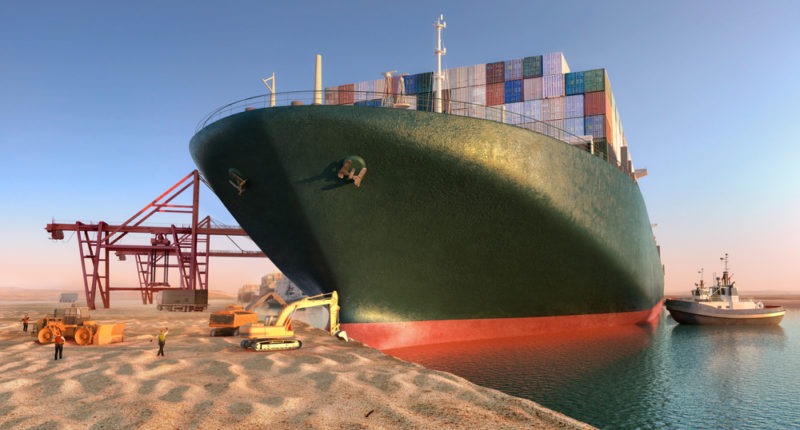Suez Canal, one of the most important canals in the world, is an artificial waterway that plays a vital role in global trade. Any adverse developments in the region are likely to have cascading impacts on the global demand-supply chain. Suez Canal is located in Egypt, one of the major countries in the Middle East. It acts as a bridge between the Red Sea and the Mediterranean Sea, dividing the continents of Asia and Africa.
As Suez Canal is located in the Middle East, it is a major route for the oil-producing countries to transport oil to many countries in the world. Recently, The Ever Given, a cargo container, was stuck in Suez Canal. It caused one of the major blockages in the region. The blockage stopped the movement of numerous ships carrying tons of cargo worth millions of dollars.
The 1,312-foot long ship got stuck in the canal last Tuesday, and the Suez Canal Authority finally managed to clear the stranded ship on Monday after numerous failed attempts. Due to the ship stuck in the canal, over 350 cargo ships were made to wait for clearance. Even though the ship’s blockage is cleared, the after-effects of the event are expected to last for a few weeks to months.
How does this impact India?
As per the data available with Vortexa, India is the largest importer of crude oil through the Suez Canal route. In fact, over two-thirds of the oil imports of India come from the Middle East region. The latest blockade in Suez Canal has already had a major impact on the shipping sector.
Fortunately, the route has been made functional again on Monday. Any further block would have made things worse, as refining operations would have taken a hit. India might have seen a major impact on its export and import of Ethane with the United States. Also, the import of crude from the South American countries, which was increased of late, would have been impacted further.
The clearance of the blockade doesn’t mean that there is no impact on India. There will be some impact as the route was clogged for a few days. The ships will reach their Indian destinations late, impacting the supply-demand chain, causing disruption in the production, which will ultimately have some impact on the price level.
How much did the blockage cost?
Many nations around the world are going to see a significant impact on their economic and trade activities, and India is no exception. India has already seen a loss exceeding a few hundreds of crore. As the Suez Canal route is among the busiest shipping routes in the world, it is natural to expect a massive disruption in the supply and demand of oil products and grains linking the western world to the east.
Also Read: GDP Estimates Suggest an Upturn in Economic Activities in India
It is estimated that clogging of the Ever Given ship cost around 12% of the global trade. As per the data available with Lloyd’s List, the blockage held up cargo and trade worth more than $9 billion a day, which is equivalent to nearly $400 million of trade an hour or $6.7 million a minute.
The crude imports of India through the Suez Canal route is in excess of 5,00,000 barrels a day. China, South Korea, and Singapore follow with their crude imports amounting to around 4,00,000 barrels per day. As per some reports, India imported nearly 5 million barrels of crude oil per day through the Suez route in December 2020, which is its peak.
Also, India is the sixth-largest exporter of crude products through Suez Canal, behind Russia, Saudi Arabia, Iraq, Libya, and Algeria. The Indian exports through the canal are estimated to be a tad lower than 2,00,000 barrels a day. The total loss of the blockage is estimated to be around $54 billion. This number is arrived at by considering only the cargo shipments that were stranded around the canal.
However, the real economic impact on countries is expected to be much higher as prices of crude oil products and gas soared amid the tension over the blockage not clearing for an extended period. As per the Suez Canal Authority, they suffered a revenue loss of $14 million to $15 million a day due to the blockage.
The cost of shipping will increase for businesses that hire ships on a charter basis as the ships are going to be in the sea for more days than expected due to the blockage. As per Reuters, the traffic formed at the canal can take more than three days to clear.
As per Allianz’s analysis, the global trade growth is expected to fall by up to 0.4% due to the Suez Canal blockage. Several retail businesses worldwide have already suffered losses as the key shipments are stranded near the canal. This is expected to cause short-term inflation in the price of some goods.
What are the steps taken to ease the traffic congestion at Suez Canal?
As of early hours on Tuesday, as many as 306 ships were waiting to go through the canal. It was 356 on Monday. To clear the traffic faster, the Suez Canal Authority is expected to increase the number of ships passing through the waterway on a daily basis. On average, the authority allows 40 to 50 ships to pass through the canal. However, the maximum permissible number is 106 a day.
Notably, as many as 81 ships sailed through the canal on the 9th of August 2019, 81 ships were authorised to sail through the waterway. Furthermore, the highest speed at which vessels are allowed in the canal is 8.6 knots. However, as per the data available with Marine Traffic, the ships are currently sailing through Suez Canal at 8 to 10 knots.
For any clarifications/feedback on the topic, please contact the writer at vineeth.nc@cleartax.in.
Engineer by qualification, financial writer by choice. I am always open to learning new things.





